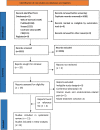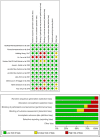Antioxidant vitamins supplementation reduce endometriosis related pelvic pain in humans: a systematic review and meta-analysis
- PMID: 37644533
- PMCID: PMC10464024
- DOI: 10.1186/s12958-023-01126-1
Antioxidant vitamins supplementation reduce endometriosis related pelvic pain in humans: a systematic review and meta-analysis
Abstract
Objective: This study aimed to clarify the effect of antioxidant vitamins supplementation on endometriosis-related pain.
Methods: A systematic search of PubMed, Web of Science, Cochrane Library, Scopus, and China National Knowledge Infrastructure (CNK) databases was conducted to identify relevant studies published in English and Chinese up to 16 March 2023. The search terms used were "endometriosis" OR "endometrioma" OR "endometrium" AND "antioxidant" OR "Vitamin C" OR "Vitamin E" OR "Vitamin D" OR "25-OHD" OR "25(OH)D" OR "25-hydroxyvitamin D". Eligible studies were randomized controlled trials (RCTs) that assessed pain scores using the Visual Analogue Scale (VAS). Mean differences or odds ratios (ORs) with 95% confidence intervals (CIs) were calculated to evaluate the effect of antioxidant vitamins supplementation on endometriosis. The quality of the included studies was assessed using the Cochrane Risk of Bias Tool. The study was conducted following the Preferred Reporting Items for Systematic Reviews and Meta-analyses (PRISMA) guidelines.
Results: A total of 13 RCTs involving 589 patients were included in this meta-analysis. We identified 11 studies that evaluated the effect of antioxidant vitamins supplementation on endometriosis-related pain. The results indicated that the supplementation of antioxidant vitamins can effectively alleviate endometriosis-related pain. Subgroup analysis showed that the supplementation of vitamin E (with or without vitamin C) had a positive effect on improving clinical pelvic pain in patients with chronic pelvic pain. Conversely, supplementation of vitamin D was associated with a reduction in pelvic pain in endometriosis patients, but the difference was not statistically significant compared to the placebo. Additionally, we observed changes in oxidative stress markers following vitamin supplementation. Plasma malondialdehyde (MDA) concentration decreased in patients with endometriosis after antioxidant vitamin supplementation, and the plasma MDA level was inversely correlated with the time and dose of vitamin E and C supplementation. Furthermore, the inflammatory markers in peritoneal fluid, including RANTES, interleukin-6, and monocyte chemoattractant protein-1, significantly decreased after antioxidant therapy. These findings suggest that antioxidant vitamins may alleviate pain in endometriosis patients by reducing inflammation.
Conclusions: The included studies support the potential role of antioxidant vitamins in the management of endometriosis. Supplementation with antioxidant vitamins effectively reduced the severity of dysmenorrhea, improved dyspareunia and pelvic pain, and enhanced quality of life in these patients. Therefore, antioxidant vitamin therapy could be considered as an alternative treatment method, either alone or in combination with other approaches, for endometriosis-related pain.
Trial registration: PROSPERO registration number: CRD42023415198.
Keywords: Antioxidant; Endometriosis; Pain; Supplementation; Vitamin C; Vitamin D; Vitamin E.
© 2023. BioMed Central Ltd., part of Springer Nature.
Conflict of interest statement
The authors declare no competing interests.
Figures








References
Publication types
MeSH terms
Substances
LinkOut - more resources
Full Text Sources
Medical
Research Materials

